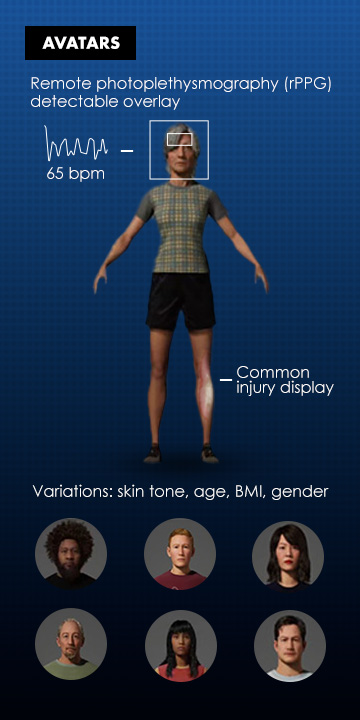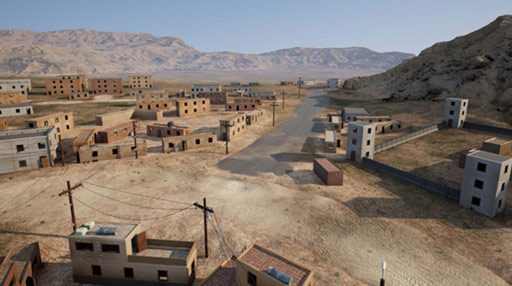Training through Simulation
Scenarios
Vitals simulated includes heart rate (skin color change), respiration (chest movement) and an array of injury patterns (lacerations, burns, airway obstruction, hemorrhage and amputations).

Modeling Injuries, Predicting Outcomes
Complementing the Systems competition, the Virtual competition created triage environments with greater degrees of freedom in terms of injury severity and physical settings where we cannot reproduce in the real-world.
Competitor teams used stand-off sensors such as cameras to evaluate casualty health status simulated by applying a high-fidelity physiology engine on virtual avatars. The event showed virtual scenarios are valuable extensions of real-world simulations, creating opportunities for sim-to-real applications.
Qualified funded and unfunded teams participated in the competitions, striving to advance the use of autonomous systems for rapid, stand-off casualty assessment to facilitate timely and accurate medical triage.
| Critical 4 points + 2 bonus each * | |
| Severe hemorrhage | Present Absent |
| Respiratory distress | Present Absent |
| Vitals 2 points + 1 bonus * | |
| Heart rate (HR) | Beats/minute (integer) |
| Respiration rate (RR) | Beats/minute (integer) |
| Trauma 2 points | |
| Head | Wound Normal |
| Torso | Wound Normal |
| Upper extremity | Wound Amputation Normal |
| Lower extremity | Wound Amputation Normal |
| Alertness 2 points | |
| Eyes | Open Closed Note testable |
| Verbal | Normal Abnormal Absent Note testable |
| Motor | Normal Abnormal Absent Note testable |
* Golden Window bonus: | |
Qualified funded and unfunded teams participated in the competitions, striving to advance the use of autonomous systems for rapid, stand-off casualty assessment to facilitate timely and accurate medical triage.
- Coordinated Robotics
- Engineering Dynamics
- Flying Fitches
- Robotika
- Second Sight
- TTT | TAK Triage Technologies
- UAS-DTU | Unmanned Aerial Systems Delhi Technological University
Index
Home | About | Events | Resources | Media Gallery

Leaderboard
| Teams | Score | ||||
| Coordinated Robotics | 369.167 | ||||
| Run 1 | Run 2 | Run 3 | Run 4 | Run 5 | Run 6 |
| 374 | 359 | 377 | 370 | 363 | 372 |
| Robotika | 345.333 | ||||
| 360 | 328 | 332 | 354 | 339 | 359 |
| Engineering Dynamics | 334.167 | ||||
| 337 | 338 | 340 | 329 | 316 | 345 |
| Second Sight | 298.167 | ||||
| 274 | 301 | 311 | 273 | 302 | 328 |
| Flying Fitches | 280.833 | ||||
| 290 | 286 | 287 | 269 | 265 | 288 |
| UAS-DTU | 103.167 | ||||
| 91 | 110 | 103 | 117 | 89 | 109 |
| TTT | 0.000 | ||||
| 0 | 0 | 0 | 0 | 0 | 0 |
Overview

Resources | FAQs | Terms and Conditions | YouTube Playlist | Media Gallery | Contact



